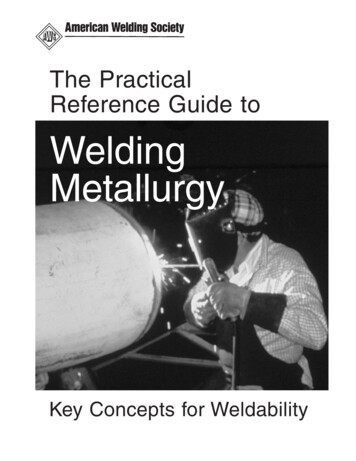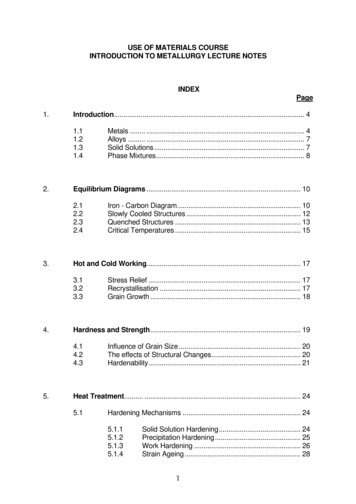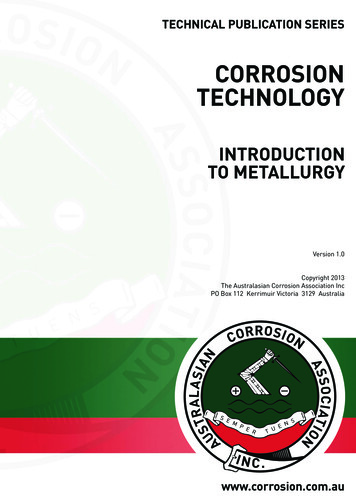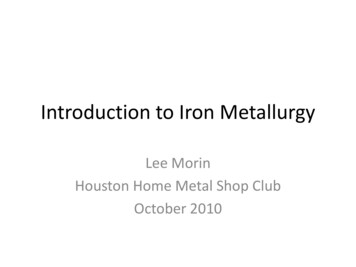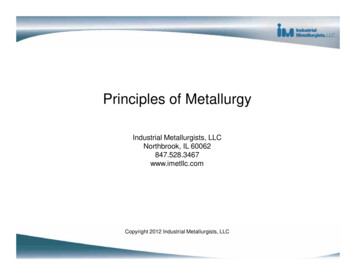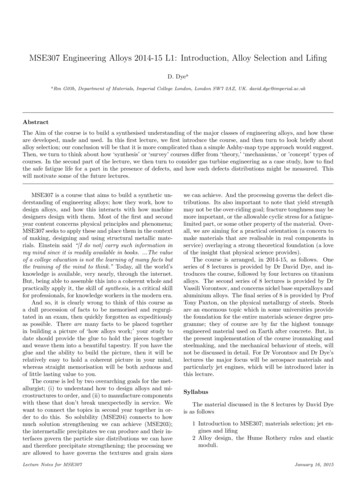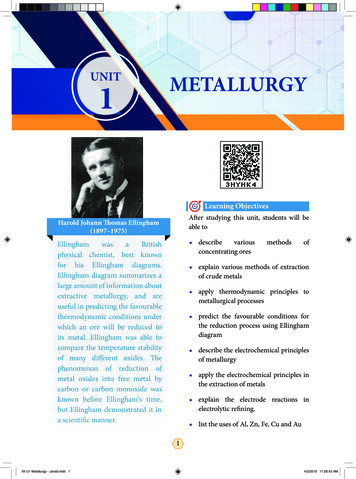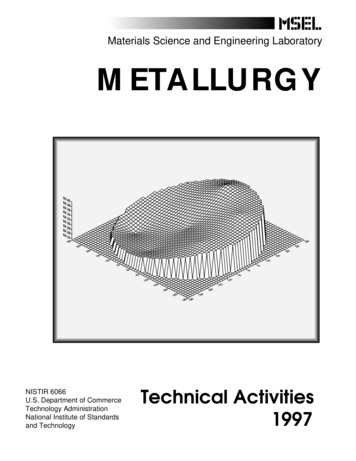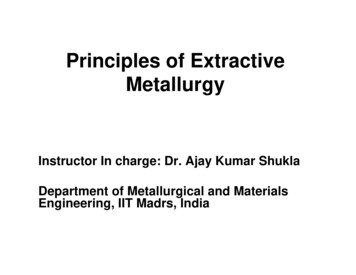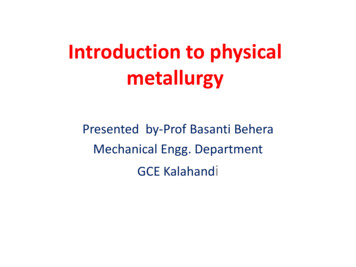
Transcription
Introduction to physicalmetallurgyPresented by-Prof Basanti BeheraMechanical Engg. DepartmentGCE Kalahandi
Module-IIConstitution of alloy- An alloy is a substance that has metallic properties and is composedof two or more chemical elements , of which at least one is metal .If the system is made oftwo element , it is called binary alloy system. Similarly three element is known as ternaryalloy system. Alloy may be classified according to their structure and completely alloy system may beclassified according to the type of their equilibrium or phase diagram. In the solid state there are three possible phase (1)Pure metal (2)Intermediate alloyphase or compound (3)Solid solution. Three most common intermediate alloy phase are: Intermetallic compound or valencecompound-These are generally formed between chemical dissimilar metals and arecombined by following the rule of chemical valence. Since thy generally have strongbonding (ionic or covalent) their properties are essentially nonmetallic .they usuallyshow poor ductility and poor electrical conductivity and may have a complex crystalstructure. Ex- Mg2Pb , Mg2Sn and Cu2Se.Interstitial compounds- These compound formed between the transition metal such asscandium (Sc), titanium (Ti), tantalum(Ta), tungsten (W) and iron(Fe), with hydrogen ,oxygen , carbon , boron and nitrogen.Electronic compound-A study of the equilibrium diagram of the alloy of copper, gold, silver,iron, and nickel with the metal cadmium ,magnesium ,tin ,Zinc, and aluminum.
Continue Example- Compound AgZn , the atom of silver has one valence electron while that Zinc hastwo valence electron so that two atom of the compound will have three valence electron ,orelectron to atom ratio 3:2 in the compound Cu9Al4 each atom of copper has one valenceelectron.There are two type of solid onal solid solution:In this type of solution the atom of solute substitute atom of the solvent. Example- Silver atomsubstitute for gold atom without losing the F.C.C structure of gold and gold atom may substitutefor silver atoms in F.C.C lattice with silver and gold atoms distributed at random through latticestructure . This entire system consist of a continuous series of solid solutionSeveral factor are now known , largely through the work of Humrothery , that control the rangeof solubility in alloy system. Crystal –structure factor- Complete solid solubility of two element is never attained unlessthe element have the same type of crystal lattice structure.Relative size factor- Size factor is favorable for solid solution formation when the differencein atomic radii's less than 8% but less than 15% the alloy system usually show minimum. Ifthe relative –size factor is greater than 15% solid solution formation is very limited.Example- Silver and lead are both F.C.C and relative size factor is about 20%. The solubility oflead in solid silver is about 1.5%, and the solubility of silver in lead is about 0.1%.
cContinueAntimony and Bismuth are completely soluble in each other in all proportion, they havesame type of crystal structure (rombohedral) and differ in atomic radii by about 7% .However the solubility of antimony in F.C.C aluminum is less than 0.1 % , although therelative size factor is about 2 %.Chemical –affinity factor-Greater the chemical affinity of two metals the more restricted istheir solid solubility and greater is the tendency towards compound formation . Generallythe farther apart the elements are in in the periodic table, the greater is their chemicalaffinity.Relative Valence factor-If the solute metals has different valence from that of the solventmetal , the number of valence electron per atom , called the electron ratio , will be changed.Crystal structure are more sensitive to a decrease in electron ratio than to an increase .Inother word a metal of lower valence tends to dissolve more of metal of higher valence thanvice versa. Example in aluminum –Nickel alloy system both metal are F.C.C . The relative sizefactor is approximately 14%. However nickel is lower in valence than aluminum , and inaccording with the relative –valence factor solid nickel dissolve 5 % aluminum, but thenhigher valence aluminium dissolve only 0.04% nickel.
Content(1)Equilibrium phase diagrams, Particle strengthening by precipitation andprecipitation reactions .(2) Kinetics of nucleation and growth(3) The iron-carbon system, phase transformations( 4) Transformation rate effects and TTT diagrams, Microstructure andproperty changes in iron carbon system
Module –III(PHASE DIAGRAM)The understanding of phase diagram for alloy system is extremely important because thereis a strong correlation between microstructure and mechanical properties and developmentof microstructure of an alloy is related to the chacteristic of the phase diagram .In addition ,phase diagram provide valuable information about melting , casting, crystallization andother phenomena. Phase diagram also called equilibrium diagram , now there are three externallycontrolled parameters that will affect phase diagram –viz. temperature, pressure andcomposition phase diagram constructed when various combination of threeparameters. One component phase diagram (unary phase diagram ) or (P-T) diagramUnary phase diagram of waterUnary phase diagram of metal
Gibbs phase rule : In a system under a set of conditions, number of phases (P) exist can be related to thenumber of components (C) and degrees of freedom (F) by Gibbs phase rule.Degrees of freedom refers to the number of independent variables (e.g.: pressure,temperature) that can be varied individually to effect changes in a system.Thermodynamically derived Gibbs phase rule : P F C 2In practical conditions for metallurgical and materials systems, pressure can be treated as aconstant (1 atm.). Thus Condensed Gibbs phase rule is written as: P F C 1Binary phase diagram In this phase diagram temperature and composition are variable and pressure held constant.Binary phase diagram are map that represent relationship between temperature andcomposition and quantity of phase equilibrium , which is influence the microstructure of analloy.If a system consists of two components, equilibrium of phases exist is depicted by binaryphase diagram. For most systems, pressure is constant, thus independently variableparameters are – temperature and composition.Two components can be either two metals (Cu and Ni), or a metal and a compound (Fe andFe 3 C), or two compounds (Al 2O3 and Si 2O 3 ), etc.Two component systems are classified based on extent of mutual solid solubility – (a)completely soluble in both liquid and solid phases (isomorphous system) and (b) completelysoluble in liquid phase whereas solubility is limited in solid state.For isomorphous system - E.g.: Cu-Ni, Ag-Au, Ge-Si, Al2O3 -Cr2O3 .
Tie line – Lever rule At a point in a phase diagram, phases present and theircomposition (tie-line method) along with relative fraction ofphases (lever rule) can be computed. Procedure to find equilibrium concentrations of phases (referto the figure in previous slide): - A tie-line or isotherm (UV) isdrawn across two-phase region to intersect the boundaries ofthe region. - Perpendiculars are dropped from these intersections to thecomposition axis, represented by U’ and V’, from which eachof each phase is read. U’ represents composition of liquidphase and V’ represents composition of solid phase asintersection U meets liquidus line and V meets solidus line.
Tie line – Lever rule (cont. .) Procedure to find equilibrium relative amounts ofphases (lever rule): - A tie-line is constructed across thetwo phase region at the temperature of the alloy tointersect the region boundaries. The relative amount of a phase is computed by taking thelength of tie line from overall composition to the phaseboundary for the other phase, and dividing by the totaltie-line length. In previous figure, relative amount ofliquid and solid phases is given respectively by:CL cV/UV C S Uc/UVCL C S 1
Stage-1Stage-2
Stage-3Stage-4
Various reactions in phase diagram
Precipitation – Strengthening – ReactionsSolutionizing (solution heat treatment),where the alloy isheated to a temperature between solvus and solidustemperatures and kept there till a uniform solid-solutionstructure is produced.Quenching, where the sample is rapidly cooled to a lowertemperature (room temperature). Resultant product –supersaturated solid solution.Aging is the last but critical step. During this heattreatment step finely dispersed precipitate particle willform. Aging the alloy at room temperature is callednatural aging, whereas at elevated temperatures is calledartificial aging. Most alloys require artificial aging, andaging temperature is usually between 15-25% oftemperature difference between room temperature andsolution heat treatment temperature.
Classification of various ferrous alloys
Low carbon steelThis type of steel generally contain less than about 0.25wt% C and are unresponsive toheat treatment. Microstructure consist of ferrite and pearlite constituent These alloy are relatively soft and weak but have good ductility and toughness , inaddition they are machinable, weldable, and all steel are least expensive toproduce. Application- pipline , buildings , bridges, tin cane etcMedium carbon steel have carbon concentration between about 0.25 and 0.60wt %CThese steel are heat treated by austenitizing quenching and tempering to improvethere mechanical properties.Addition of cromium nickel and molybdenum improve capacity of these alloys to beheattreated.Application –Railway wheel, track, gear, crankshaft and other machine part etc.High carbonsteel- High carbon steel , normally carbon content between 0.60 and1.4wt%C are hardest , strongest and least ductile carbon steels.Tool and die steel are highcarbon alloy usually containg cromium ,vanadium , tungstenand molybdenumApplication- Cutting tool , dies, knives,razor, spring etc
Stainless steelStainless steels generally contain between 10-20% chromium as the mainalloying element and are valued for high corrosion resistance. With over 11%chromium, steel is about 200 times more resistant to corrosion than mild steel.These steels can be divided into three groups based on their crystallinestructure:Austenitic: Austenitic steels are non-magnetic and non-heat-treatable, andgenerally contain 18% chromium, 8% nickel and less than 0.8% carbon.Austenitic steels form the largest portion of the global stainless steel marketand are often used in food processing equipment, kitchen utensils, and piping.Ferritic:Ferritic steels contain trace amounts of nickel, 12-17% chromium, lessthan 0.1% carbon, along with other alloying elements, such as molybdenum,aluminum or titanium. These magnetic steels cannot be hardened by heattreatment but can be strengthened by cold working.Martensitic: Martensitic steels contain 11-17% chromium, less than 0.4%nickel, and up to 1.2% carbon. These magnetic and heat-treatable steels areused in knives, cutting tools, as well as dental and surgical equipment.
Tool Steels Tool steels contain tungsten, molybdenum, cobalt andvanadium in varying quantities to increase heatresistance and durability, making them ideal for cuttingand drilling equipment. Steel products can also be divided by their shapes andrelated applications: Long/Tubular Products include bars and rods, rails, wires,angles, pipes, and shapes and sections. These productsare commonly used in the automotive and constructionsectors. Flat Products include plates, sheets, coils, and strips.These materials are mainly used in automotive parts,appliances, packaging, shipbuilding, and construction. Other Products include valves, fittings, and flanges andare mainly used as piping materials.
CCast Iron-Castiron are a class of ferrous alloy with carbon content aboveͦ2.14wt% . Most of the cast iron contain 3.0-4.5wt% C Its melting point approximately 1150 & 1300 ͦC which is lower than the steel ,so it is easily melted amenable to casting. Cast iron are very brittle , therefore casting is most convenient fabricationtechnique. Most common cast iron type are gray ,nodular ,white malleable compactedgraphite.Gray cast iron – Iron consist of carbon 2.5-4.0wt%C & silicon 1.0 & 3.0 wt%C forma gray cast iron. Mechanically ,gray iron is comparatively week and brittle in tension It is very useful , in damping vibration energy Gray iron exhibit high resistance to wear. Furthermore , in molten state they have high fluidity at casting temperature,which permits casting piece having intricate shpe
Ductile Iron- Adding small amount of magnesium and cerium to gray ironbefore casting produces a distinctly different microstructure & set ofmechanical properties. Graphite form in nodular or sphere like particle instead of flakes. Casting are stronger and much more ductile than gray iron Application- valve, pump bodies, crank shaft, gears etc.White iron and malleable Iron- For low –silicon cast iron (containingless than 1.0wt%Si) and rapid cooling rate ,most of the carbon exist ascementite instead of graphite. An optical photomicrograph showing the micro structure of white iron ispresented As a consequence of large amount of cementite phase white iron isextremely hard but also very brittle , to the point of being virtually unmachinable. Its use is limited to application that necessitate a very hard and wearresistance surface, without a high degree of ductility Ex- Rollers in rolling mills.
Heat treatment process :SolidificationCompositionHeat
Heat treatment process -Definition:Heat Treatment can bedefined as a combination of Heating and Cooling Operationscarried out on a metal or alloy in the solid state so as to producea Particular Microstructure and hence the Desired Properties. Generally the Composition is fixed and the Solidification isalso completed the only way to change the properties is byHeat treatment. Heat Treatment effectively alters the Size and Shape of theGrains and also type (SCC, BCC, FCC, HCP etc) and Distributionof grains hence the PROPERTIES
Objectives Heat Treatment To improve the Mechanical Properties.To improve Machinability.To increase Wear Resistance.To modify Electrical & Magnetic Properties.To Refine the Grains.To produce Hard Surfaces & Soft Inner Core.To Relieve Internal (Residual) Stress due toMechanical Working. To Over come effects of Strain Hardening &Restore Ductile Property.
Various Stages of Heat Treatment Process Stage1: Heating the metal or the alloy to theprescribed temperature. Stage2: Holding the specimen at thattemperature for a known time period (holdingtime or Soaking time-depends upon thethickness of the specimen). Stage3: Cooling at a rate (Slow or Rapid rate)necessary to obtain a specific microstructurefor the desired properties (Furnace Cooling,Air cooling, Water Cooling, Oil cooling, & Icecooling).
Types of Heat Treatment 1.Annealing Processa.Full Annealing process.b. Partial Annealing Processc.Spheroidising Annealing Process2. Normalizing3. Hardening4. Temperinge. Austemperingg.f. Martempering
Type of surface heat treatment process1.Case hardening (involves an intentional built up or addition of a newlayer with increase in part dimensions)(i) Carburizing(a)Pack Carburizing(b)Gas Carburizing.(c) Liquid Carburizing(ii) Cyaniding(iii) Nitriding2. Surface hardening-(surface or sub-surface modification without anyintentional built up or increase in part dimensions)(i) Flame hardening(ii) Induction hardening
Annealing process- Objective of annealing process is tosoften the metal , to refine its grain structure, to relive stressand remove gasses trapped in metal. This process consists ofheating the steel 30 ͦc- 50 ͦc above the upper criticaltemperature. The steel is held at this temperature forsometime to enable internal changes to take place.The time allowed is approximately 3 to 4 minutes,and then slowly cooled in furnace.Normalizing process- The process in which steel heatup 30 ͦc- 50 ͦc above upper critical temperature , thenit is held at this temp. for 15 minutes and then allowcool down in steel air.This process provide a homogeneous structureconsisting of ferrite and pearlite, homogeneousstructure provide higher yield point, ultimate tensilestrength.
Spherodising process- it is a particular type ofannealing in which cementite in granular formis produced in the structure of steel , this isusually , applied to high carbon tool steel ,whichare difficult to machine. The operation consistsof heating steel up to a temperature slightlyabove the lower critical temp.(730 ͦc - 770 ͦc). It isheld at this temp. for sometime and thencooled slowly to temp. 600 ͦc.The spherodising improves the machinability ofsteel , but lowers the hardness and tensilestrength. The steel have better elongationproperties than normally annealed steel.
Hardening process- the main objective of are toincrease the hardness of the metal ,so that it canresist wear. The metal up to a temp of 30 ͦc-50 ͦcabove upper critical temp. A rapid cooling form thehardening temp. Cause the austenite to betransformed into another constituent calledmartensite, which is very hard and brittle.Tempering- the main objective of tempering is toreduce brittleness of hardened steel and thus toincrease in ductility.Steel is heated to low tempering temp(200 ͦc-250 ͦc),the internal stress are reduced and ductilityincreases.
Carburising- The process of introducing carbonto low carbon steel , in ordered to give hardsurface is called carburising.In this process , the article to be placed in acarburising box which is filled with carbon dust,and the process is keep at elevated temperaturefor specified period , during heating carbonmonoxide gas is formed which react witharticle to form carbon and carbon dioxide gas.The article absorbed carbon into the body ofarticle.
Nitriding process- this is also surface hardeningprocess , in this process nitrogen gas is employed inorder to obtain hard surface of the steel . Thisprocess is commonly used for those steel , which isalloyed with chromium , molybdenum,aluminiumetc. the nitriding process is generally carried out inelectric furnace with the temp. of 450 ͦc-550 ͦc .thecontainer with the article is placed in the furnaceand ammonia gas is passed through it. Theammonia gas when come in contact with steelarticle get dissociated in the form of nitrogen ,which react with surface of article and formednitride which is very hard
Cyaniding- (also called liquid carburising) in processsurface hardening is done with both carbon andnitrogen are absorbed by the metal surface to getharden . A piece of low carbon steel is immersed ina bath of cyanide salt maintained temp. of 850 ͦc950 ͦc.Flame hardening- sometime , a particular portion ofan article is required to be hardened . This isgenerally done in case of portion subject to wear ,abrasion or shock. This type of local hardening isdone by a process , known as flame hardening .inthis process the portion , to be hardened ,is heatedwith the help of flame or oxyacetylene torch aboveits critical temp.
Induction hardening - it is the process of surfacehardening in which surface to be hardened , issurrounded by an inductor block which act as aprimary coil of transformer. The inductor blokshould not touch the surface to be hardened ,Ahigh frequency current is passed through thisblock .the heating effect is due to induced eddycurrent and hysteresis losses in the surfacematerial.
Optical property of materialContent1) Basic concepts2) Optical properties of metals3) Optical properties of non-metals4) Applications of optical phenomena C
Introduction Engineering materials are important in everydaylife because of their versatile structuralproperties. Other than these properties, they do play animportant role because of their physicalproperties. Prime physical properties of materials include:electrical properties; thermal properties;magnetic properties; and optical properties. The optical properties of engineering materialsare useful in different applications. Ex.:domestic,medicine,astronomy,manufacturing
Cont. Optical property of a material is defined as its interactionwith electro-magnetic radiation in the visible. Electromagnetic spectrum of radiation spans the wide rangefrom γ-rays with wavelength as 10-12 m, through x-rays,ultraviolet, visible, infrared, and finally radio waves withwavelengths as along as 105 m. Visible light is one form of electromagnetic radiation withwavelengths ranging from 0.39 to 0.77 μm. Light can be considered as having waves and consisting ofparticles called photons.
Introduction to physical metallurgy Presented by-Prof Basanti Behera Mechanical Engg. Department GCE Kalahandi . Module-II Constitution of alloy- An alloy is a substance that has metallic properties and is composed of two or more chemical elements ,
